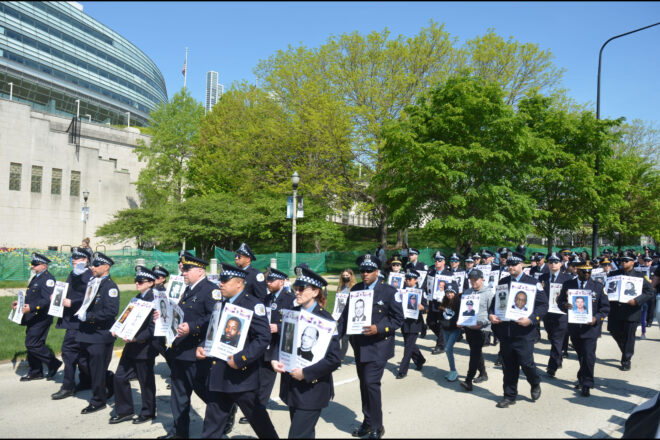Do you remember when Dr. Jack Kevorkian and assisted suicide were a major discussion in the medical field? It may be time for us to start having a similar discussion about violence in America’s larger towns and cities. We seem to be witnessing a new type of assisted suicide in far too many communities. Correction the assisted suicide of communities. The Summer 2021 issue of “Thinking Minnesota” provides an excellent summary of the collapse of public safety in the Twin Cities area. In Minnesota, and many other areas of the nation, a cadre of “new Kevorkian” leaders has emerged. These leaders have assisted in creating community conditions more vulnerable to lawlessness. In that wake, deadly violence has dramatically increased.
Estimated reading time: 15 minutes
The Kevorkian Path
We are told that those who died with Dr. Kevorkian’s assistance wanted to die. However, with the assisted suicide of a community, those who are murdered did not seek to die. Murder and suicide are clearly different. But, a community that fosters the lawlessness that repeatedly ends in the murder of its own members is in a sense killing itself. Any officials with public safety responsibilities that weaken the response to violence are complicit in the metaphorical assisted suicide of their community. They are members of the cadre of new Kevorkian leaders.
Over the span of about eight years in the 1990s, Dr. Kevorkian assisted in the deaths of about 130 people. In 1999, he was convicted of second-degree murder for one death, his last assisted suicide, which occurred in 1998. Kevorkian argued it was appropriate for medical doctors to assist terminally-ill patients to opt out early from the pain of life-ending illnesses. There are many who agree with Kevorkian’s view of individual assisted suicide for the terminally ill, as an act of compassion.
However, even if we are saying that the nation’s cities are terminally-ill, hastening their death is far from an act of compassion. In reality it is people within cities plagued with violence who die. It is their deaths and the overall breakdown of public safety that, if left uncorrected, kills a community. At Secure 1776 we continue to sound the alarm against lawless Hadleyvilles caught in a horror version of Groundhog Day. But sadly, the jury is still out on what the future will bring for the Twin Cities and places like them.
Violence in the Twin Cities
Jenna Stocker wrote the cover story for the Summer 2021 issue of Thinking Minnesota. The article entitled, “Freefall,” highlights the role that local leadership has had in the decline of public safety in Minneapolis and Saint Paul. The subtitle of Stocker’s article read: “State and Twin Cities leaders dither while vulnerable residents live in fear and increasing danger.” In a key passage, Stocker reports about the collapse of public safety in the metro area:
“Residents and business owners are subject to nightly terror. None of the destructiveness comes at the hands of police or as a manifestation of systemic racism in law enforcement, as many radical activists like to claim. It’s the consequence of too few police on the streets, of politicians defending criminals instead of victims, and of unconditioned vilification of the law enforcement officers who pledge to protect the communities they serve.”
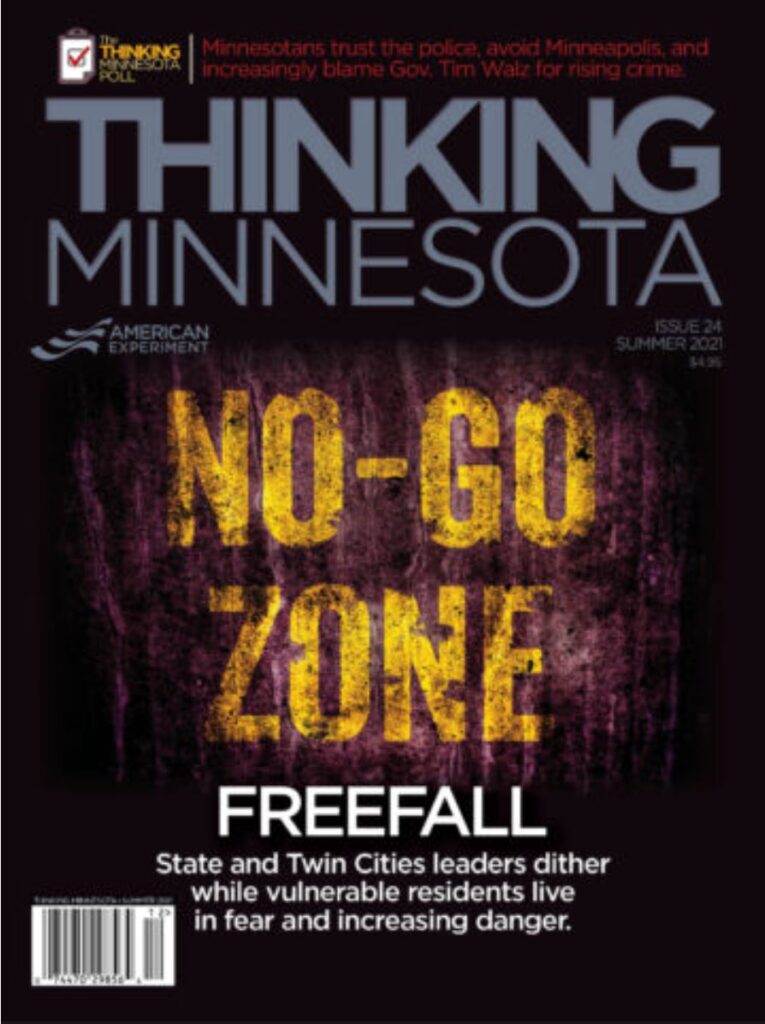
Stocker chronicles the surge in violence that has occurred in the Twin Cities, since the now infamous 25 May 2020 George Floyd incident in Minneapolis. Quoting: “The untenable violence destroying the Twin Cities is the result of a failure of civic leaders to protect their citizens and support our law enforcement. And it’s only going to get worse.”
She also described a 30 May 2021 protest at the intersection where the Floyd incident occurred. However, the protest on May 30th this year was different from the protests there in May of last year. Rather than a protest against the police, hundreds gathered to demand improved public safety and action to address the city’s violence. Including the murders of two children under age 10 in separate incidents.
Signs of a Community Killing Itself – Murdered Children
Nine-year-old Trinity Ottoson was shot in the head while playing on a trampoline on 15 May 2021. Six-year-old Aniya Allen was shot in the head while eating a “happy meal,” as she rode in her family’s car on 17 May 2021. These are incidents that are reflective of a lawless city.
As reported by KARE11 News, Minneapolis Police linked ballistic evidence from the murder of Aniya Allen to a shooting six days earlier. The suspect charged in the prior shooting was already out on bond. The gun from these two shootings has not been recovered, and no one has been charged in the murders of either six-year-old Aniya or nine-year-old Trinity.
CBS Minnesota on 9 September reported on the murder of London Bean, a 12-year-old Minneapolis boy. Reportedly, this murder stemmed from a fight between two youths. The shooter is also believed to be a child. London Bean was the 62nd murder victim in Minneapolis this year. In all of 2019, there were 48 murders. Thus far in 2021, violence in the city has continued to be at the elevated levels that emerged last year. In 2020, there were 84 murders in Minneapolis, up 75.0% from the 2019 tally.
None of the three child murders highlighted above has been cleared with an arrest. Such is unfortunately consist with current trends in Minneapolis. Analysis conducted by Professor Manjeet Rege, of the University of St. Thomas, found 88% of the city’s crimes this year are currently unsolved.
In October 2009, Forbes Magazine identified Minneapolis as “America’s Safest City:” Then former New Yorkers, who had moved to Minneapolis, gushed about the area and its “shockingly low crime rates.” That was then. A lot has changed.
Comparisons on Violence in Minneapolis
On 8 September 2021, the Star Tribune ran the following headline: “Minneapolis’ bloody summer.” Below the headline, they ran the following: “A surge in gunshots in some areas have put the city on pace for its most violent year in a generation.” The Star Tribune quoted a 55-year-old resident, Juliee Oden as saying of her neighborhood: “You hear gunfire, it’s like hearing birds chirping in the morning.” The newspaper analyzed gun-related crime data from police and the FBI for the city.
As compared to the averages for 2008 thru 2019, thus far in 2021, there are dramatic increases. Data updated as of 10 September showed homicides this year up 76%. Shooting reports were up 150%, and ShotSpotter activations up 222%.
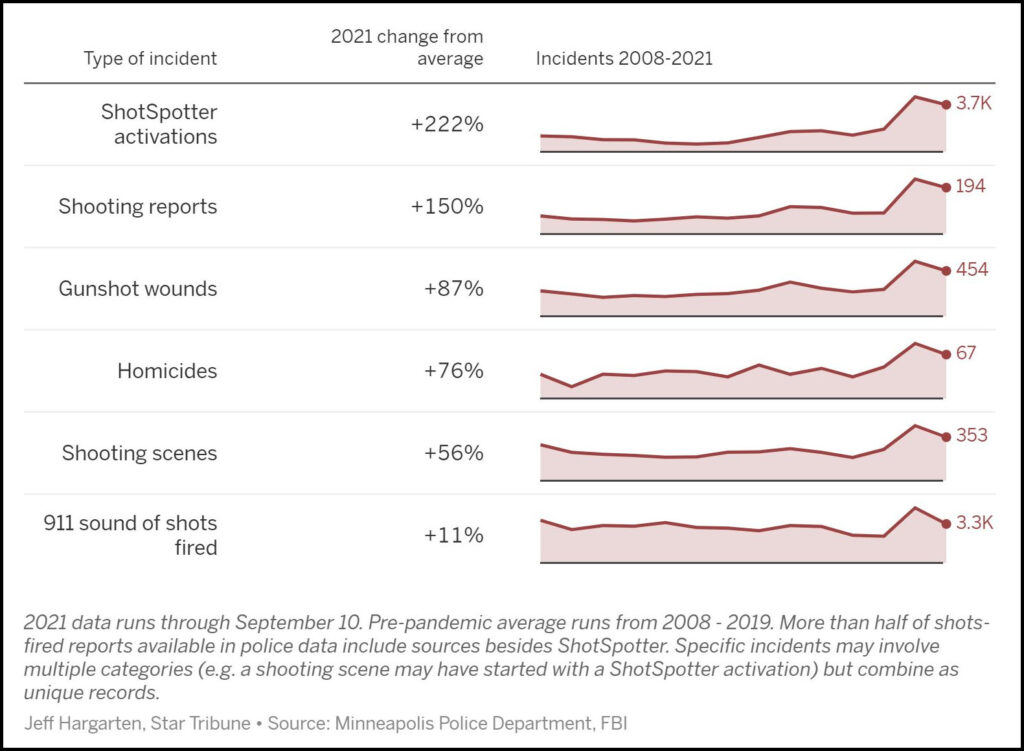
A 57-year-old Minnesota resident, Etta Riley, spoke with the Star Tribune. Riley, who lives in the Cleveland neighborhood, sees a memorial placed in front her house for six-year-old Aniya each day. She commented how politicians rallied there right after her murder, but not since. Dave Haddy, a 48-year-old resident from the Jordan neighborhood, added: “We get excuses and we get finger-pointing. And the people who say they are supporting us with all of their efforts, where are they? Haddy concluded: “I’m sorry, but the people advocating [defunding police] the most don’t live in these scenarios. Ask North Siders, at least the ones I talk to. They are not for abolition. They are for competent, just policing.”
A City Council’s Opposition to its Own Police
The demonization of policing in Minneapolis since the 25 May 2020 Floyd incident has been beyond intense. Within days of the incident, the progressive members of the Minneapolis City Council were seeking to fully disband the city’s police department. By 26 June 2020, the 12-member council unanimously approved its first measure to abolish the department. The council advocated for the creation of a new “Department of Community Safety and Violence Prevention.” The proposed agency would take a “public health-oriented approach” to crime.
The Minneapolis City Council has been relentless in its efforts to dismantle the city’s police department. Sadly, rather than the raging violence in the city, the council was slowed in eliminating its police force only by the city’s charter. The charter currently mandates the city have a police department. It also sets a minimum police staffing level tied to the city’s population. On 30 June 2021, a Hennepin County judge ruled in favor of residents who sued the city over its failure to maintain its required minimum police staffing number. As of July, Minneapolis had 669 police officers, which was 61 fewer than mandated by the charter minimum.
Modifying or removing the police department and staffing charter provisions requires voter approval. A hastily written ballot question for the November 2020 election was blocked by a judge. However, this past week, the Minnesota State Supreme Court has cleared the way for the initiative to appear on this November’s ballot. This overturned a lower court’s ruling stating that the ballot initiative wording was too vague. The measure does not make clear how police officers will be utilized, nor how many officers will remain under the new department. What is clear, the less-than-police-friendly city council will have far greater control over the new agency. Mayor Jacob Fry does not support the council’s “reform” plan.
In Stocker’s “Freefall” article, she noted the Minneapolis police force has witnessed the departure of 300 officers since early 2020. That loss of experienced officers is a factor in the city’s rising violence. She has observed that “the city is surrendering its civility.” Yet simultaneously, the city council has continued to focus most on its drive to dismantle its police department. On 17 May 2021, Lisa Bender, the President of the Minneapolis City Council tweeted the below comments. Recall, this is the same day that six-year-old Aniya Allen was murdered while eating a “happy meal.”
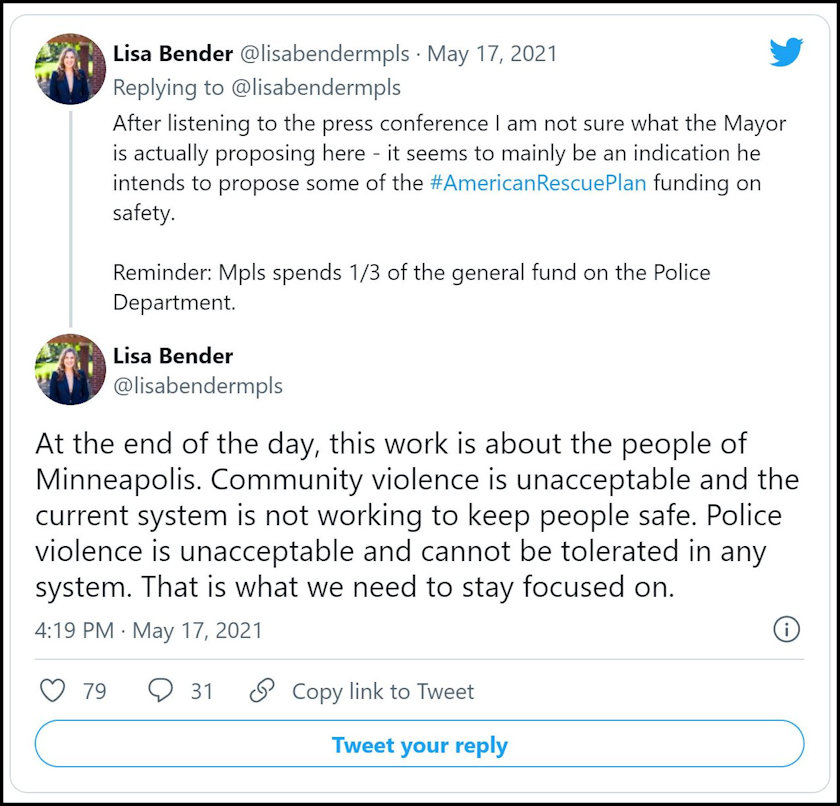
The death of George Floyd in May 2020 was an event that has left permanent marks on the community and the policing profession. Such is without question. But, it bears noting that in the wake of that event, the violence taking lives in Minneapolis – including those of children – has not been due to “police violence.” It is the result of a growing lawlessness. Lawlessness reaped from a troubling anti-police atmosphere sowed by activists, anarchists, and many local politicians. These are the makings for the assisted suicide of a city.
More Signs of a Public Safety Collapse
In a Reuters News article on 13 September 2021, Carlos Barria also reported on the lawlessness ongoing in Minneapolis. A detailed analysis of police field operations and crime data provided an alarming conclusion relative public safety in Minneapolis. Reuters determined that since the Floyd incident: “Minneapolis’ police officers imposed abrupt changes of their own, adopting what amounts to a hands-off approach to everyday lawbreaking in a city where killings have surged to a level not seen in decades.” Relative to policing in Minneapolis post-Floyd, Secure 1776 notes the following additional points from the Reuters article:
- “Police officers have all but stopped making traffic stops.”
- The step back by police was “driven by fear that any encounter could become the next flashpoint.”
- The U.S. Justice Department is “conducting a wide-ranging investigation into whether Minneapolis officers for years used excessive force, discriminated against minorities and adequately disciplined misconduct.”
- A recently retired police commander was quoted as saying: “Nobody in the job or working on the job can blame those officers for being less aggressive.”
- Minneapolis Mayor Jacob Frey stated: “Our city and our officers are having to handle a host of issues that no other jurisdiction wants to touch with a pole.”
- A department spokesman reported that staffing shortages have hampered the ability of the department to do much more than respond to radio calls. The department had 22% fewer officers to “put on the streets this year than it did in 2019.”
- “The number of people charged with breaking gun laws dropped by more than half, even as shootings multiplied.”
- “Three law enforcement experts interviewed by Reuters say a less active police force can most definitely impact community safety.”
- “… for citizens affected by the escalating gun violence, the reduced police presence has triggered a fear that criminals can act with impunity.”
- A resident, who “has spent time in prison,” and initially supported the anti-police protests, has observed: “police no longer seem to patrol.” This same resident described the current environment in Minneapolis as a “gangster’s paradise.”
- A woman, who heads the nonprofit named “A Mother’s Love,” commented on the lawlessness. She said the city has “spun out of control.”
- As indicated in the below graphic, proactive policing responses, across a broad range of factors, have declined significantly.
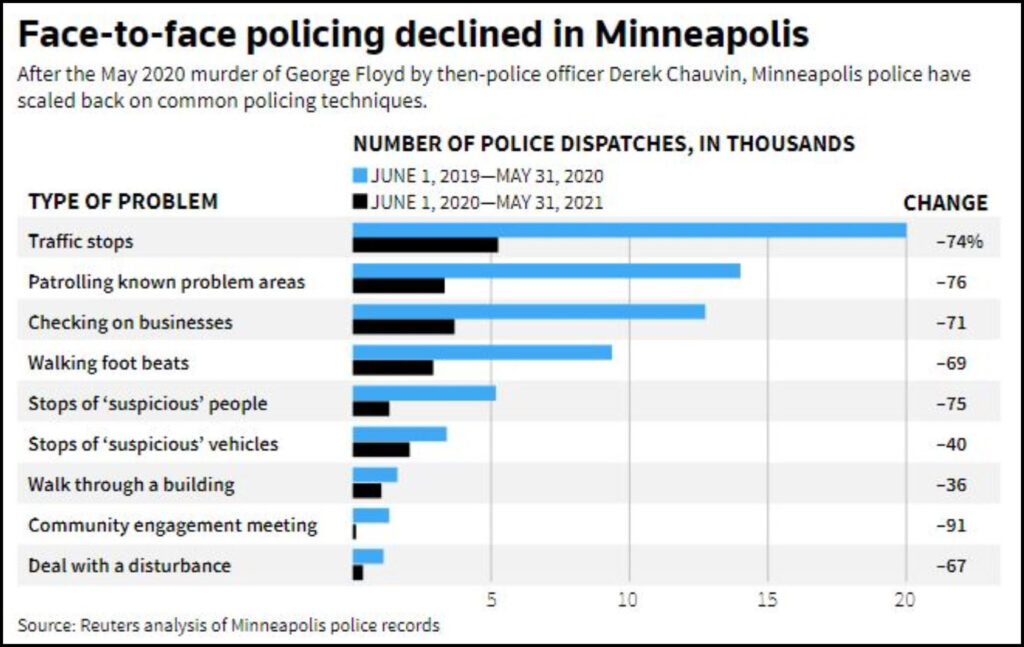
When the Prosecutor Tags Out
The Ramsey County prosecutor, John Choi has codified an acceptance of lawlessness in Saint Paul. Choi unilaterally issued a policy that his office would no longer prosecute crimes discovered subsequent to a minor traffic violation. This decision not to prosecute included felony offenses. It is a move that was unfortunately applauded by the Star Tribune, the leading newspaper for the Twin Cities. But as noted by criminologist Justin Nix, from the University of Nebraska Omaha, traffic enforcement can be an effective approach to addressing gun violence. Quoting Nix, from a 17 September 2021 American Experiment article: “More frequent stops make it riskier for people to carry guns illegally.”
In response to the non-enforcement approach of County Attorney Choi, the Ramsey County Deputies’ Federation issued a statement. The federation condemned the prosecutor for “circumventing the legislative process.” Additionally, they criticized the prosecutor’s use of the term “pre-textual traffic stop.” The statement continued: “To unilaterally decriminalize illegal activity discovered pursuant to a legal traffic stop is a betrayal of the office of county attorney and sends a strong signal to those engaged in criminal activity that they can do so with impunity.”
More on What the Community Wants
Minneapolis voters in November may approve the measure to create a public safety department to replace the current police department. However, despite the rhetoric consistent with the assisted suicide of a once peaceful Minneapolis, the community does not want fewer police officers.
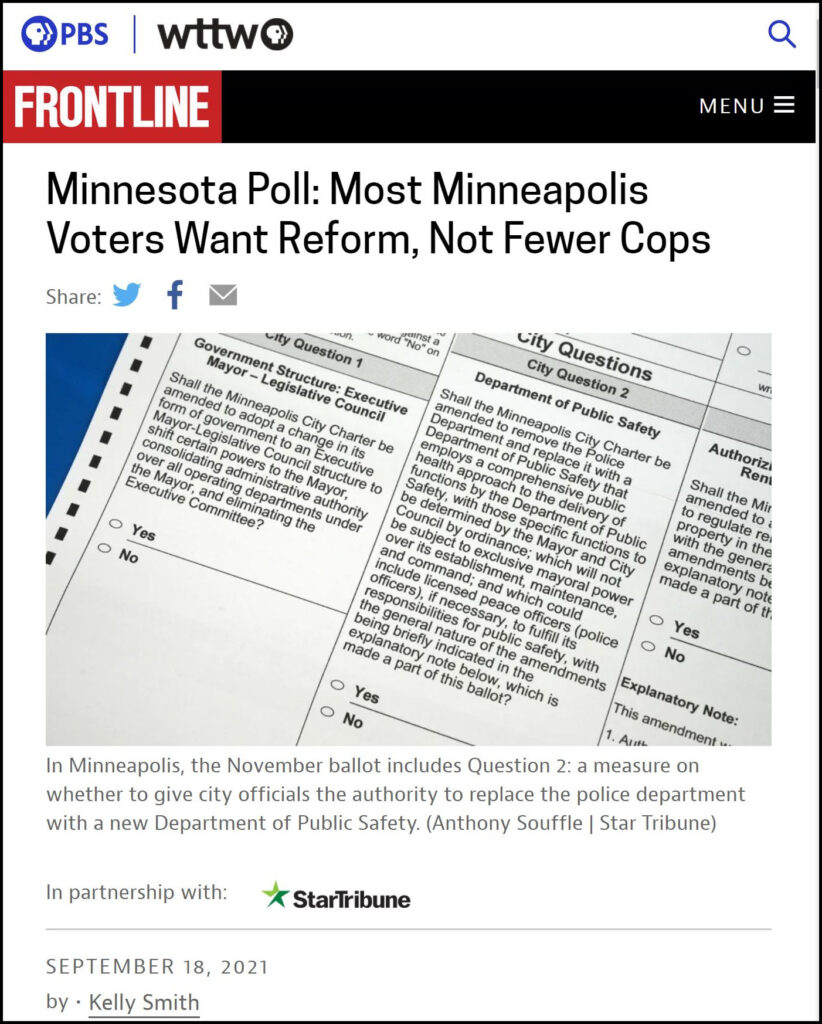
Polling conducted for PBS and the Star Tribune found opposition to reducing the city’s number of police officers. Overall 55% of likely voters surveyed between 9 Sep and 13 Sep did not want fewer police officers. This was nearly twice the number of likely voters who indicated that they did want fewer officers. Opposition to replacing the police department has also been expressed by the downtown business community.
Of particular note, 75% of Black voters opposed reducing the number of police officers. Similarly, only 42% of Blacks expressed support for replacing the police department. Such would seem to be a firm rejection of an assisted suicide approach to public safety. Also of note: Twin Cities PBS reported that as of the end of July, so far in 2021, 8 of 10 gunshot victims in Minneapolis were Black.
So it seems, the portions of Minneapolis most impacted by the surge in crime in the city are the least receptive to a further diminished police force. Apparently, like George Bailey from “Its a Wonderful Life,” the people in the areas with the most violence “want to live again.”
Police or No Police? Suicide or Life?
Will the Minneapolis Police Department be replaced? It remains to be seen how the voting will turn out. The political stakes are high. At a minimum, city leaders appear compelled to rebrand the police department. In doing so, they would be wise to listen to those most impacted by their city’s violence. If not, their city will move further along the pathway to assisted suicide.
Minnesotans must guard against the rise of any “new Kevorkian” leaders. Whether they are misguided or deliberate in their actions, the assisted suicide of our communities is not the path forward. Those efforts that seek to demonize the police and weaken the police-community relationship must cease. Violent offenders must be held accountable, and victims of crime need to be a priority within the justice system. Additionally, the community in Minnesota overall must be credible in its demands for public safety.
The community has a right to demand for itself both constitutional policing that is respectful of civil liberties and public safety. For their children, the community has an obligation to demand its elected officials and civic leaders foster unifying approaches that: (1) advance constitutional policing, (2) reduce violence, (3) address chronic crime conditions, (4) improve public safety, (5) protect victims, (6) foster officer wellness, and (7) enhance community support for the police.
The way forward must be a proactive one. In this effort, it is essential for us not to be deceived by those who are seeking perpetual division for their own ideological and political purposes. When the police are one with the community, the community is safer, freer, more stable, and better positioned to help foster the improved well-being of the entire community. Those seeking and participating in police reform efforts must not lose sight of this reality. The very life of the community itself is at stake.
Not Familiar with the Hadleyville Reference?
As an introduction to our discussion on “Hadleyvilles,” Secure 1776 continues to recommend reading the article entitled, “It’s High Noon for American Policing,” by Thomas Lemmer. We also recommend his article entitled, “The Importance of “Us:” The Failure of Being Cast as Them,” and then “Tragedy-Free Policing or Else: The Need for Critical Thinking.” Finally, we recommend reading our other “in the news” posts with the Hadleyville tag.
We are interested in your thoughts, and invite you to comment below.

Copyright Protected | (c) 2021 Secure1776.us – All rights reserved.

